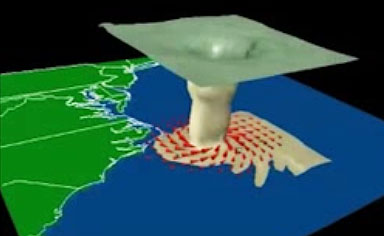"My primary goal is to improve the computer models that are used for hurricane predictions
in real time." |
A collaborative effort between Isaac's lab at the University of Rhode Island and the NOAA Geophysical Fluid Dynamics Lab in Princeton, New Jersey, the coupled model became operational in 2001 as the first coupled atmosphere/ocean weather forecast system implemented at the US National Weather Service, and has continued to run since then.
Developing computer models is the work of a mathematician – which is what Isaac was trained to be, with an undergraduate degree in applied mathematics. As a young mathematician interested in applying his skill to real world problems, he discovered that he could apply numerical modeling to the study of typhoons in the Pacific Ocean – which became the focus of his PhD.
|
Weather forecasting models predict weather on a global scale, whereas hurricanes are regional events. Isaac is working on developing a regional computer model with much higher resolution in the hurricane core region. It has a "movable mesh system" that moves with the storm, continually resolving the three-dimensional structure of the hurricane. "Our goal is to cover the atmosphere and ocean with the finest possible resolution or grid," says Isaac. "This is revolutionary science, to be able to simulate an extreme weather event around the world using high resolution weather models."


